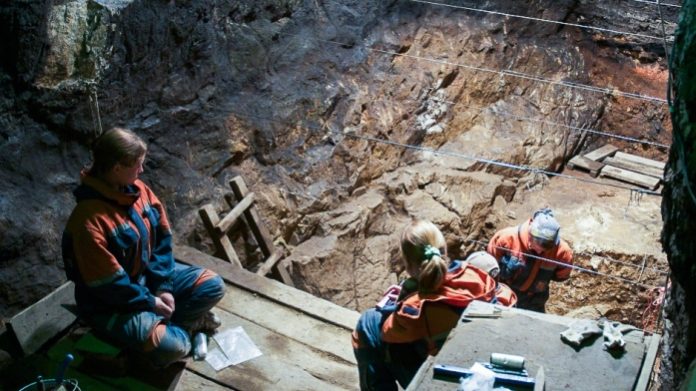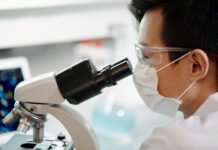Neanderthals might not be the only ancestors that helped us become who we are today. Researchers are adding a newly discovered hominin to our lineage.
Professor Bence Viola, a paleoanthropologist in the Department of Anthropology at the University of Toronto is one of these researchers. Viola uses morphological, genetic, and archaeological approaches to analyze early hominin fossils from Central and Northern Asia as well as Europe.
Cave of Wonders
He studies fossils found in Denisova cave in Siberia, Russia, yielding exciting discoveries. The cave, called Bear Rock by the local people and inhabited in the 18th century by a hermit from whom it gets its name, is in the Bashelaksky Range in the Altai Mountains, close to Russia’s border with Kazakhstan, and near Mongolia and China. It’s in an area where there have been many interesting finds since the Soviets started excavating in the late 1970s.
Recent research has revealed that humans interbred with Neanderthals more than expected. But there was also gene flow between other archaic relatives, some of whom ended up in Denisova cave.
Viola already had intuition about the cave during his PhD when writing about a tooth found there. Teeth are especially revealing fossils, and based on this tooth, Viola suggested that there were things in the cave that were neither modern human nor Neanderthal. It turned out the tooth was from a bison – not exactly a new hominin, but Viola would be ultimately right about the cave and future fossils unearthed there.
A Natural Fridge
After finishing his PhD in 2009, Viola joined a team headed by Svante Pääbo at the Max Planck Institute of Evolutionary Anthropology in Leipzig, Germany, studying ancient DNA extracted from fossil remains – mostly Neanderthal “because we had no idea there’s anything else,” said Viola.
The team did fossil genetic analyses on two types of DNA: mitochondrial DNA (mtDNA), a smaller molecule consisting of only 18,000 base pairs, and thus easier to study; and nuclear DNA, which is much larger (3 billion base pairs) and thus more complicated and expensive to sequence. Both types of DNA are extracted from small, 30 milligram samples taken from the fossils.
But taking a sample does not ensure genetic analysis is possible; DNA is not always preserved in all fossils. Viola explained that hot and humid areas are bad for DNA preservation, which is unfortunate because throughout human history the majority of humans lived in warmer areas.
However, the Denisova cave is in the chilly Altai Mountains, and the fossils were discovered at the back of the cave, where conditions were constant over hundreds of thousands of years. “It’s like a natural fridge,” said Viola. The team was able to extract well-preserved mtDNA from a finger bone fragment found in the cave.
“I was very lucky,” Viola recounted. “The day I moved to Leipzig, I got an email saying, ‘You have to come to the Institute right now. We have something very weird.’”
The extracted mtDNA had yielded surprising results, explained Viola, “We already knew Neanderthal mtDNA and of course we knew modern human mtDNA, but this mtDNA was neither. This was something completely different from both.”
Sink Your Teeth Into It
The DNA was from a new hominin, which the team named the Denisovans after the site. Hardly able to believe it, Viola flew to Russia to share the discovery with his colleagues, but they had an even more exciting find: they pulled out a new, surprisingly large tooth they had discovered in the cave. This time, clearly not a bison tooth.
“That was for me really the seminal moment. Taking this thing in my hand,” Viola chuckled. “This actually looked like something different. So it was a tooth that was really, really striking and gave me the feeling that this is really true.”
Teeth, Viola explains, are excellent and frequent fossil remains. Tooth enamel is the hardest part of our bodies and thus most likely to survive in the archaeological record. Fragmentary bone remains, such as the very small piece of the finger bone found first, are often difficult to identify. But teeth, if you are an expert like Viola, can tell you much more.
Tooth enamel is analyzed for growth much like tree rings. Modern human teeth grow much slower than Neanderthal teeth did, from which, Viola suggests, we can infer some developmental differences between humans and Neanderthals.
But what about Denisovans, how do they compare? Unfortunately, Viola can’t yet say much, only that they are genetically different (though not deemed a separate species). And that they have bigger teeth.
Fitting In
Curious about how they fit in the hominin lineage, Viola and the team are doing phylogenetic analyses, which so far suggest that Denisovans are closer to Neanderthals than they are to modern humans. But Neanderthals have recently been shown to be more closely related to us than previously thought: up to 1.5 to 2% of our genomes come from Neanderthals. So perhaps Denisovans might not be so far off genetically.
It turns out they are far off in a different way. Viola expected to find some Denisovan genetic contribution in individuals in Russia, Mongolia or China – areas close by. Not so. Denisovan genetic contribution is highest 8,000km away in the Melanesians of Papua New Guinea, who carry an additional 6% of Denisovan DNA. This suggests that Denisovans were more widespread, living all over Asia, but that we just have not recognized or found them yet. Far off genetic contributions such as these and others the team has found have left scientists puzzled.
It’s likely that some of these genes were adaptive, and therefore selected for, Viola suggests. These are possibly linked to immunological adaptations, high altitude acclimatization and more, revealing that our shared genetic lineage is often to our benefit. Being called a Neanderthal or Denisovan is not an insult!
Neanderthal Deserts
But there are also unshared areas of our genomes, Viola explained, called “Neanderthal deserts”. “These must be the areas that make us who we are, because those are the few things where all modern humans are different from Neanderthals.” But he added “There is surprisingly little.” While the deserts are larger, only 200 locations in the genome code for proteins that are unique to modern humans compared to Neanderthals.
All these claims should be tempered by the fact, Viola explains, that we don’t know much. “We have all these genomes of Neanderthals and Denisovans, but it will take many, many years for us to actually gather the information that’s in there.” Viola is at the forefront as new fossils are found and new questions arise.
He is headed to Siberia again, where fossils have been discovered in another cave. “It’s very, very cool,” he said excitedly, because among them there is a Neanderthal jawbone with teeth, which will be an excellent fossil for analysis. The jawbone could reveal more about these distant human relatives, a piece of whom some of us may still carry around in our genomes. We’ll have to wait to find out.









































